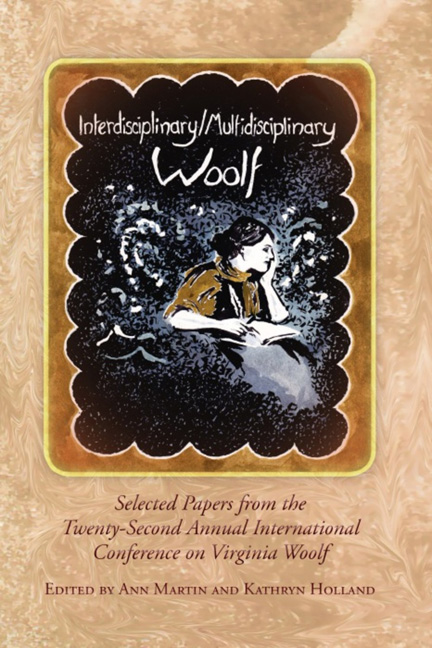Book contents
- Frontmatter
- Contents
- Introduction to Interdisciplinary/Multidisciplinary Woolf
- Acknowledgments
- List of Abbreviations
- History, Materiality, Multiplicity
- Multidisciplinary Woolf / Multiple Woolfs?
- Woolf, History, Us
- “Full of Experiments and Reforms”: Virginia Woolf, John Maynard Keynes, and the Impossibility of Economic Modeling
- Desiring Statues and Ambiguous Sexualities in Jacob's Room
- Challenging the Family Script: Woolf, the Stephen Family, and Victorian Evangelical Theology
- History as Scaffolding: Woolf's Use of The Times in The Years
- Vincent van Gogh, Virginia Woolf, and Old Shoes: A Cross-Cultural Iconography of Historical Truama from the Great War to the Iraq War
- Stopped at the Border: Virginia Woolf and the Criminalization of Dissent in Democratic Societies
- “Q. And babies? A. And babies”: On Pacifism, Visual Truama, and the Body Heap
- Photography, History, and Memoir of the Spanish Civil War: Interdisciplinary Views
- Patterns, Practices, Principles
- Art, Influence, Embodiment
- Publishing, Politics, Publics
- Notes on Contributors
- Conference Program
Vincent van Gogh, Virginia Woolf, and Old Shoes: A Cross-Cultural Iconography of Historical Truama from the Great War to the Iraq War
from History, Materiality, Multiplicity
- Frontmatter
- Contents
- Introduction to Interdisciplinary/Multidisciplinary Woolf
- Acknowledgments
- List of Abbreviations
- History, Materiality, Multiplicity
- Multidisciplinary Woolf / Multiple Woolfs?
- Woolf, History, Us
- “Full of Experiments and Reforms”: Virginia Woolf, John Maynard Keynes, and the Impossibility of Economic Modeling
- Desiring Statues and Ambiguous Sexualities in Jacob's Room
- Challenging the Family Script: Woolf, the Stephen Family, and Victorian Evangelical Theology
- History as Scaffolding: Woolf's Use of The Times in The Years
- Vincent van Gogh, Virginia Woolf, and Old Shoes: A Cross-Cultural Iconography of Historical Truama from the Great War to the Iraq War
- Stopped at the Border: Virginia Woolf and the Criminalization of Dissent in Democratic Societies
- “Q. And babies? A. And babies”: On Pacifism, Visual Truama, and the Body Heap
- Photography, History, and Memoir of the Spanish Civil War: Interdisciplinary Views
- Patterns, Practices, Principles
- Art, Influence, Embodiment
- Publishing, Politics, Publics
- Notes on Contributors
- Conference Program
Summary
“What am I to do with these, Mr. Bonamy? She held out a pair of Jacob's old shoes.” (JR 187)
I situate Woolf's representations of “old shoes,” especially her striking evocation of the death of Jacob Flanders during the Great War (1914-1918), within a cultural genealogy that includes the Dutch Post-Impressionist painter Vincent van Gogh (1853-1890), the Yiddish poet Moses Schulstein (1911-1981), and the Iraqi journalist Muntadhar al-Zaidi (1979–). This paratactic analysis investigates the implications of Woolf's memorable image, addressing the multidisciplinary interests of Bloomsbury and the transhistorical instances of war. Susan Stanford Friedman's model of parataxis, with its “conjuncture of seemingly disparate cultural texts,” inspires my methodology: in addition to literature, I juxtapose artifacts, paintings, and performances (“CP” 37). Throughout, I strive to “avoid the categorical violence of comparison within the framework of dominance” while observing “commonalities” across differences of culture, faith, gender, genre, history, and language (Friedman, “WN” 758). Van Gogh's influential painting A Pair of Shoes (1886) serves as a precedent in this discussion: his broken boots with creased leather, skewed tongue, and unraveled lace capture the cumulative exertions and fragile conditions of the body though visible brush strokes. In turn, Schulstein personifies empty shoes as “the last witnesses” to the Nazi genocide in “I Saw A Mountain” (1954), a poem cited at the United States Holocaust Memorial Museum (line 20). More recently, al-Zaidi, the author of The Story of My Shoe (2009), protested the plight of Iraqis during the “Global War on Terror” by throwing his footwear at former United States President George W. Bush. By positioning Woolf in relation to an artist, a poet, and a journalist, I aim to illuminate the cross-cultural import of her arresting image of untimely death: old shoes.
The shoe, a staple of human transit, physical protection, and social identity, signals the vulnerability of precarious life, particularly in periods of political crisis. Conditions of “precarity,” risks of bodily and psychological exposure heightened or systematically introduced in contexts of war, include bereavement, death, deportation, disease, homelessness, malnutrition, trauma, and torture: as Judith Butler maintains, “War is precisely an effort to minimize precariousness for some and to maximize it for others” (FW 25, 54).
- Type
- Chapter
- Information
- Interdisciplinary/Multidisciplinary Woolf , pp. 50 - 56Publisher: Liverpool University PressPrint publication year: 2013



